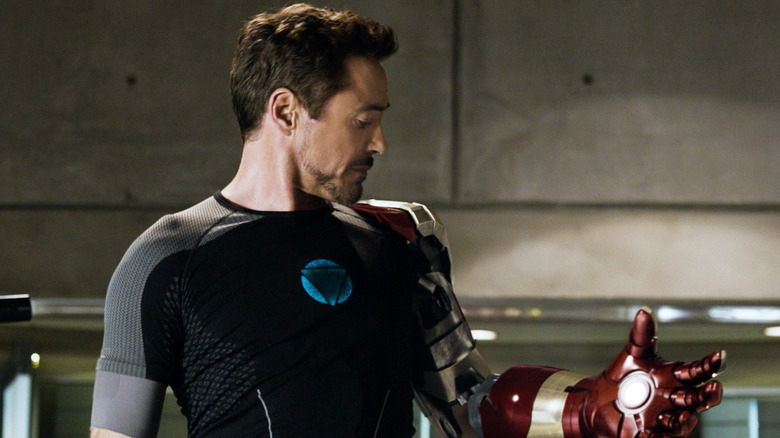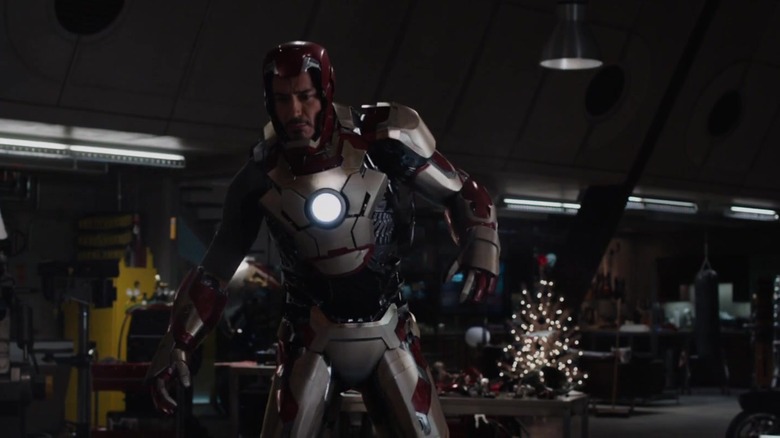Robert Downey Jr. Invented A Whole 'Language' For Summoning Iron Man's Suit
In Jon Favreau's 2008 superhero film "Iron Man," Tony Stark (Robert Downey, Jr.) spends a large portion of the movie inventing and building a high-tech, skintight suit of armor that is equipped with rocket boosters, missiles, and automated servos that increase Tony's physical strength. In order to put the suit on, Tony required an additional, assembly-line-like machine that sealed the various pieces of the armor around his body.
In the many "Iron Man" sequels that followed, however, the process of getting in and out of the suit became quicker and more streamlined. In one film, Tony thrusts his fists into a briefcase, and his suit stretches and assembles around him. Later, the "assembly line" process is so swift that Tony can remove his suit without having to stop walking. Eventually — and perhaps boringly — the suit became a sort of liquid metal like in "Terminator 2," shlorping around Tony almost instantly.
In Shane Black's excellent "Iron Man 3," Tony implants magnetic trackers throughout his body and then gestures dramatically to "summon" his suit. The individual chunks of Iron Man armor fly through the air and attach themselves to Tony piece by piece. In an amusing opening scene, the armor pieces don't exactly assemble in the way Tony expected and end up falling off his body.
In the mythos of the film, Tony Stark would need some kind of "activation" gesture or password that he would use to summon the armor, a gesture which he demonstrates early in the scene. Practically, actor Downey, Jr. had to do the same, inventing a codified body language that he would use throughout "Iron Man 3." Downey, Jr. talked about his gestures in "Iron Man 3 Unmasked," a short behind-the-scenes documentary about the making of the film, available on Disney+.
The Iron Man gesture
In the short documentary, Downey can be seen briefly explaining his gestures. To "activate" the magnets in his body, Downey decided, he would raise his right index finger with his left fist clasped behind his back. That, he said, was a gesture indicating that he was in control. Then, to summon the first piece of armor, he held his right elbow at a 90-degree angle from his body, keeping his fist aloft, while thrusting his left arm forward, palm up. After catching a few pieces on his body as a test, Downey then held up two "hang loose" gestures (hands raised with pinkies and thumbs extended) to summon the rest of the pieces all at once.
The documentary then proceeds to show how Downey was thrown around the room — using mostly cables and pulleys — as the pieces of armor hit him. The armor was animated with CGI, so Downey not only had to invent the gestures but also do some extensive mime work, imagining that certain pieces of the armor were already on his body.
In another parallel to in-film details, the SFX technicians had to pepper Downey's body with motion-capture points to animate the armor on him after the fact. The motion-capture points were located more or less where Tony implanted the magnets.
Later in the film, Tony Stark is kidnapped by the movie's Big Bad and handcuffed to an upright bed frame in a dingy warehouse. Luckily, the gestures still work even when he can't move his arms, and Downey only needs to flick his hand open to summon his armor.
There were still limitations to the flying armor, though, which made "Iron Man 3" fun and interesting. It's one of the best films in the Marvel Cinematic Universe.

